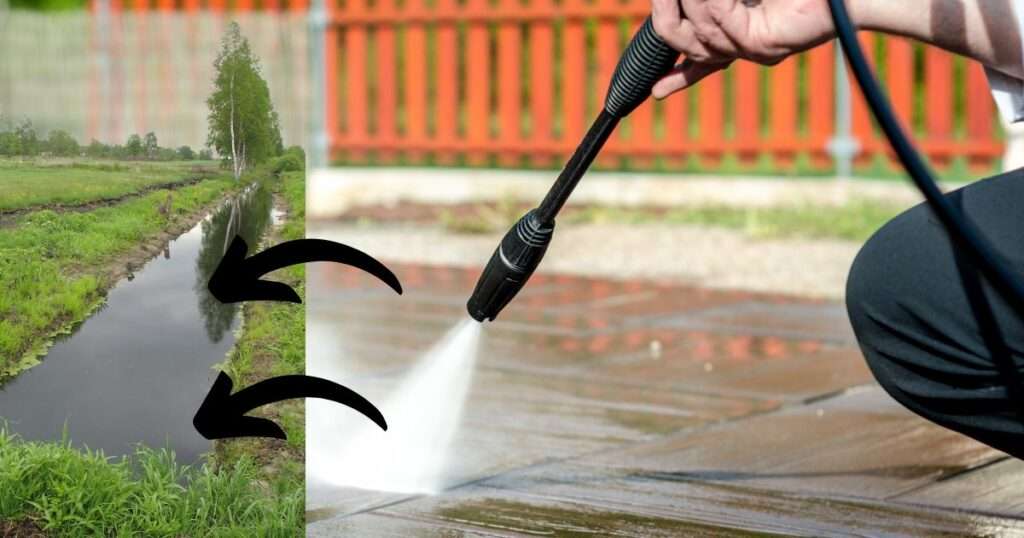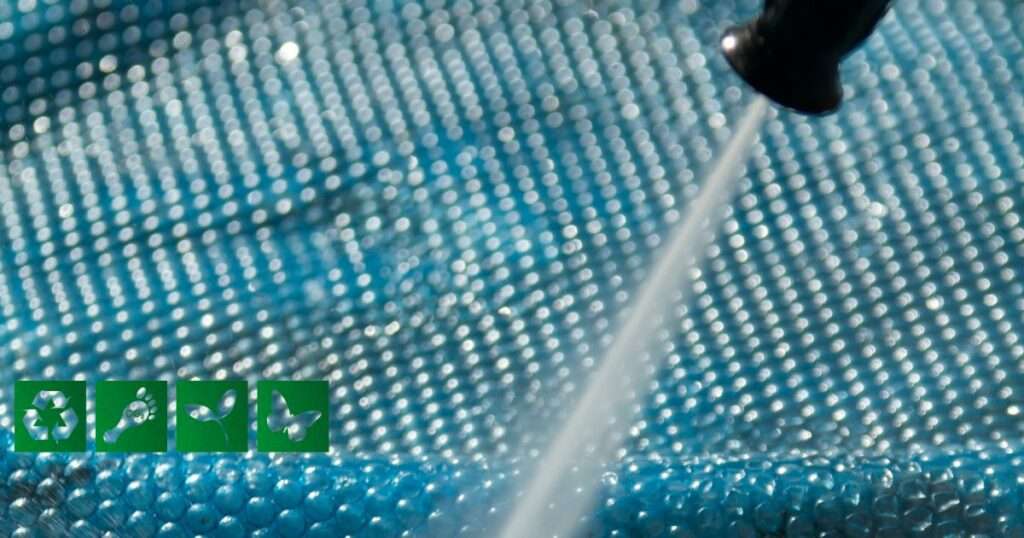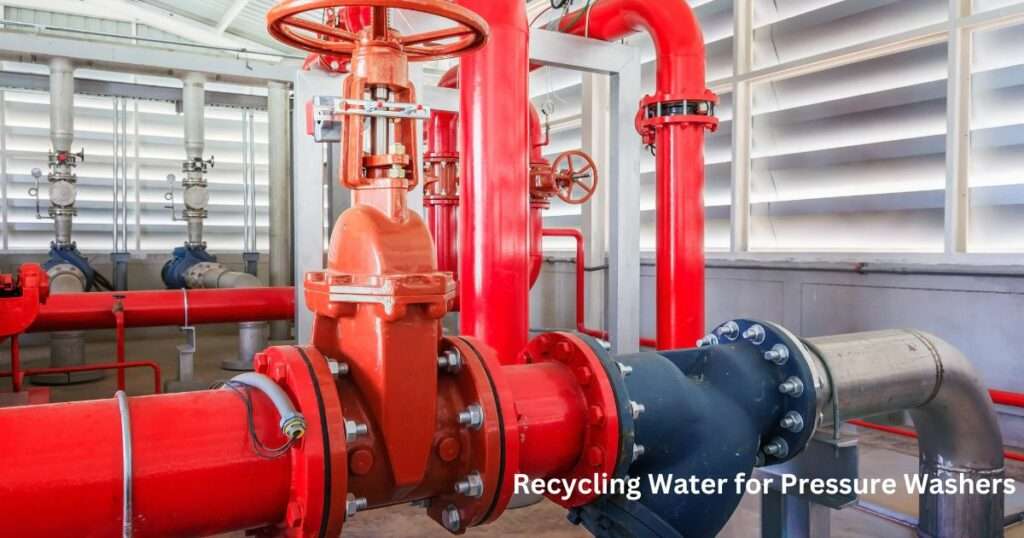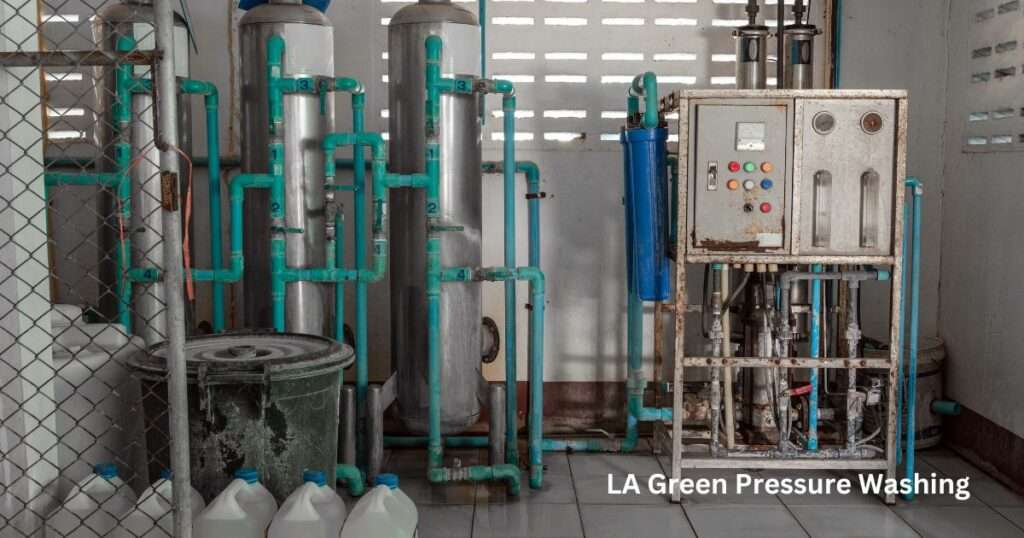Implementing a water reclamation system for pressure washing greatly enhances efficiency and sustainability. You capture and recycle up to 80% of wastewater, which cuts costs and minimizes environmental impact.
The system includes a collection mechanism, primary and secondary filters, and advanced filters like activated carbon to guarantee thorough purification. Efficient pumps and storage tanks maintain smooth operation and adaptability.
Reclaimed water usage reduces the strain on local resources and wastewater discharge, offering considerable savings on water bills. Proper installation and regular maintenance are essential.
Explore how aligning these choices with your sustainability goals maximizes your operational benefits. Discover sustainable solutions that maximize efficiency and minimize costs.
Key Takeaways
- Water reclamation systems capture, filter, and store runoff for reuse in pressure washing, reducing water consumption and environmental impact.
- They include components like collection mechanisms, multiple filter stages, storage tanks, and efficient pumps to ensure effective operation.
- Using reclaimed water lowers operational costs, minimizes freshwater usage, and demonstrates a commitment to sustainability.
- Key considerations include system type, cost analysis, and compatibility with existing equipment for optimal integration and performance.
- Regular maintenance of filters and pumps ensures water quality and system efficiency, contributing to overall sustainability goals.
Understanding Water Reclamation

Although it might seem straightforward, understanding water reclamation is vital for efficient pressure washing operations. When you engage in pressure washing, water recycling becomes an important aspect, not only for cost efficiency but also for reducing environmental impact.
By reclaiming water, you guarantee that the runoff doesn’t contribute to pollution, thereby maintaining the ecological balance and complying with environmental regulations.
This allows you to use water resources prudently, aligning with the principles of sustainability and freedom of operation without excessive regulatory constraints.
In pressure washing, capturing and reusing water minimizes the need for freshwater, which is increasingly important in areas facing water scarcity.
By implementing a robust water reclamation system, you can directly improve the efficiency of your operations, reducing overhead costs associated with water usage.
In addition, a well-designed system prevents contaminants from entering stormwater systems, which can lead to significant environmental damage.
Components of the System

To effectively reclaim water during pressure washing, you need a thorough understanding of the system’s components.
The key components include a collection mechanism, filtration units, and storage tanks. Each part plays an important role in ensuring the system’s efficiency.
The collection mechanism captures runoff water, which is essential for minimizing waste and environmental impact.
When it comes to filtration, selecting appropriate filter types is significant. Primary filters remove large debris, while secondary filters handle smaller particulates.
You might consider advanced options like activated carbon filters to eliminate contaminants and improve water quality. The choice of filters directly influences the system’s efficiency and the quality of reclaimed water.
Storage tanks are where reclaimed water is held for reuse. The size and material of these tanks can affect your freedom to adapt the system to different scales and settings.
Efficient pumps are necessary for transferring water between components, ensuring smooth operation without unnecessary energy use.
Understanding these components allows you to optimize your water reclamation system, giving you the flexibility to adjust for varying operational needs while maintaining system efficiency. This approach not only maximizes resource use but also aligns with sustainable practices.
Benefits of Using Reclaimed Water

Utilizing reclaimed water in pressure washing systems offers numerous advantages that enhance both operational efficiency and environmental responsibility. By choosing reclaimed water, you greatly reduce the environmental impact of your cleaning operations.
Water reclamation systems allow you to recycle and reuse water, minimizing the strain on local water resources and decreasing wastewater discharge. This practice supports sustainable operations, aligning with eco-friendly business models that many modern enterprises aim for.
From a cost-savings perspective, using reclaimed water can lead to considerable financial benefits. You’re not just saving on water bills but also reducing the associated costs of wastewater treatment and disposal.
Reclaimed water systems can lower your dependence on municipal water supplies, providing long-term cost efficiency. Additionally, these systems can enhance your operational flexibility, as you’re less vulnerable to water restrictions or supply shortages.
Incorporating reclaimed water into your pressure washing processes doesn’t just reflect a commitment to sustainability; it’s a financially savvy move.
You’re empowering your business to operate more independently and efficiently while demonstrating a forward-thinking approach to resource management.
This blend of environmental consciousness and economic prudence grants you the freedom to innovate and lead in your industry.
Installation and Maintenance Tips

Having recognized the benefits of using reclaimed water in pressure washing, it’s important to understand the practical aspects of installing and maintaining these systems.
Start by evaluating your current setup and determine how a water reclamation system will integrate. Ascertain compatibility with existing equipment to avoid unnecessary disruptions.
Keep an eye on system upgrades, as technological advancements can enhance efficiency and reduce operating costs over time.
During installation, pay attention to connections, ensuring they’re secure and leak-free. Inspect filters and pumps regularly, as they play critical roles in maintaining water quality and pressure.
Don’t overlook the importance of a well-organized layout to facilitate easy access for maintenance tasks.
Maintenance requires a proactive approach to keep the system running smoothly. Familiarize yourself with troubleshooting techniques to quickly address issues like clogs or pressure drops.
Routine checks and timely replacements of worn-out components can prevent costly downtime. Document your maintenance activities to spot patterns and anticipate future needs.
Choosing the Right System

When selecting the right water reclamation system for pressure washing, consider both the specific demands of your operations and the characteristics of available systems.
Start by evaluating system types. Closed-loop systems are efficient for operations requiring minimal water discharge, while open-loop systems provide flexibility for larger applications.
Each type offers distinct benefits and constraints, so align these with your operational goals and environmental responsibilities.
Next, conduct a detailed cost analysis. Don’t just focus on the initial purchase price. Factor in installation, maintenance, and operational costs over the system’s lifecycle.
A more expensive system might offer long-term savings through reduced water usage and lower maintenance demands.
This analysis guarantees that you’re investing in a system that aligns with both your budgetary constraints and environmental commitments, promoting sustainable practices without compromising efficiency.
Emerging Trends in Water Reclamation Technologies

As environmental awareness grows, businesses are increasingly seeking advanced water reclamation technologies to enhance efficiency and sustainability.
Modern systems now incorporate cutting-edge features like real-time monitoring sensors that track water quality at each stage of the filtration process.
These sensors ensure reclaimed water meets operational standards, reducing the chances of equipment damage or cleaning inefficiency caused by contaminants.
Another trend is the integration of smart technology and artificial intelligence (AI) into water reclamation systems. AI-driven algorithms can analyze usage patterns, optimize filtration performance, and predict maintenance needs before issues arise, significantly reducing downtime.
These intelligent systems also adjust filtration settings automatically to handle varying levels of debris and pollutants, ensuring a seamless cleaning experience with minimal human intervention.
Additionally, portable water reclamation units are gaining popularity among businesses with mobile pressure washing operations. These compact, high-performance units allow for efficient water recycling on the go, making them an excellent choice for companies that service multiple locations.
By incorporating such systems, pressure-washing businesses can showcase their commitment to sustainable practices, even in off-site operations.
Lastly, innovations in energy-efficient components—such as low-power pumps and eco-friendly filter materials—are making these systems more cost-effective and environmentally friendly.
By reducing the carbon footprint associated with water reclamation, these advancements align with broader global efforts to combat climate change.
Staying informed about these emerging trends not only strengthens your competitive edge but also demonstrates your dedication to offering top-notch, eco-conscious services.
By investing in advanced technologies, you’re setting your business apart as an industry leader in sustainable pressure-washing solutions.
Frequently Asked Questions
How Does Water Reclamation Impact the Environment Positively?
You understand that water reclamation enhances ecosystem health by conserving water, reducing pollution, and maintaining natural habitats.
You’re supporting freedom for ecosystems to thrive while responsibly managing resources, ensuring a sustainable future for our environment.
Are There Any Legal Requirements for Implementing a Water Reclamation System?
Imagine a city imposing fines for non-compliance with local ordinances. You must understand regulatory compliance to avoid penalties.
Review your area’s legal requirements, as they vary widely, and guarantee your system aligns with all applicable regulations.
Can Reclaimed Water Be Used for Other Cleaning Applications Beyond Pressure Washing?
You can utilize reclaimed water for various cleaning tasks beyond pressure washing. Its benefits include cost savings and environmental impact reduction.
Embrace alternative cleaning methods, such as floor scrubbing or vehicle washing, enhancing operational efficiency and sustainability.
What Is the Cost Savings Potential With a Water Reclamation System for Pressure Washing?
Ever wondered how much you could save? By installing a water reclamation system, you can markedly cut costs.
Though system installation and maintenance costs are upfront, long-term savings on water bills offer financial freedom and sustainability.
How Long Does It Take to See a Return on Investment With These Systems?
You’ll typically see a return on your initial investment within 1-3 years. The long-term benefits include reduced water costs and environmental impact, offering you the freedom to operate sustainably and economically in the long run.
Conclusion
You’ve mastered water reclamation for pressure washing, and you’re practically a superhero saving the planet, one drop at a time.
With the right system, you’re not just blasting grime but turning waste into wannabe rainbows. Your components are like an elite team of operatives, efficiently capturing and recycling water.
Sure, maintenance is your sidekick, but it’s all worth it when you see the benefits. Choose wisely, and you’ll be the maestro of moisture, orchestrating a sustainable symphony.